🎯 By the end of this guide,
You’ll be able to rank molecules based on their SN1 reactivity by evaluating:
- The stability of the resulting carbocation
- The ability of the leaving group
✋ Before we start
Make sure you’re comfortable with:
- Substitution reactions
- Characteristics of SN1 reactions
Let’s dive in!
Challenge 1: Ranking Molecules with the Same Leaving Group
Question:
Rank the following molecules in order of increasing SN1 reaction rate (from slowest to fastest).

Step 1: Identify the carbon attached to the leaving group
Let’s start by figuring out the type of carbon the leaving group is attached to in each molecule. By identifying this, we can predict the type of carbocation that will form when the leaving group departs.
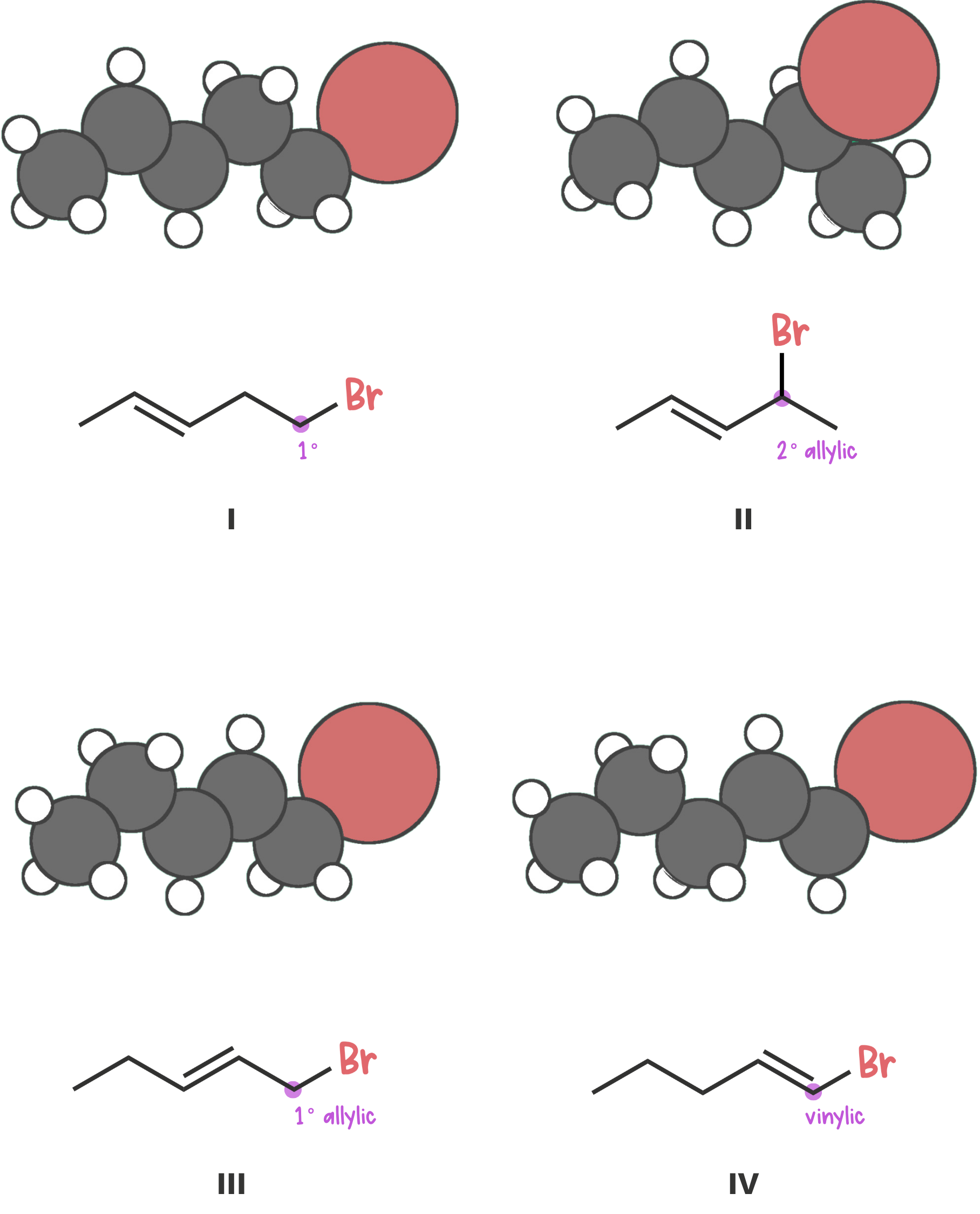
- Molecule I: Bromine is attached to a primary (1°) carbon.
- Molecule II: Bromine is attached to a secondary (2°) allylic carbon.
- Molecule III: Bromine is attached to a primary (1°) allylic carbon.
- Molecule IV: Bromine is attached to a vinylic carbon (part of a double bond).
Step 2: Evaluate carbocation stability
In an SN1 reaction, the rate-determining step is the formation of a carbocation after the leaving group departs. The more stable the carbocation, the faster the reaction.
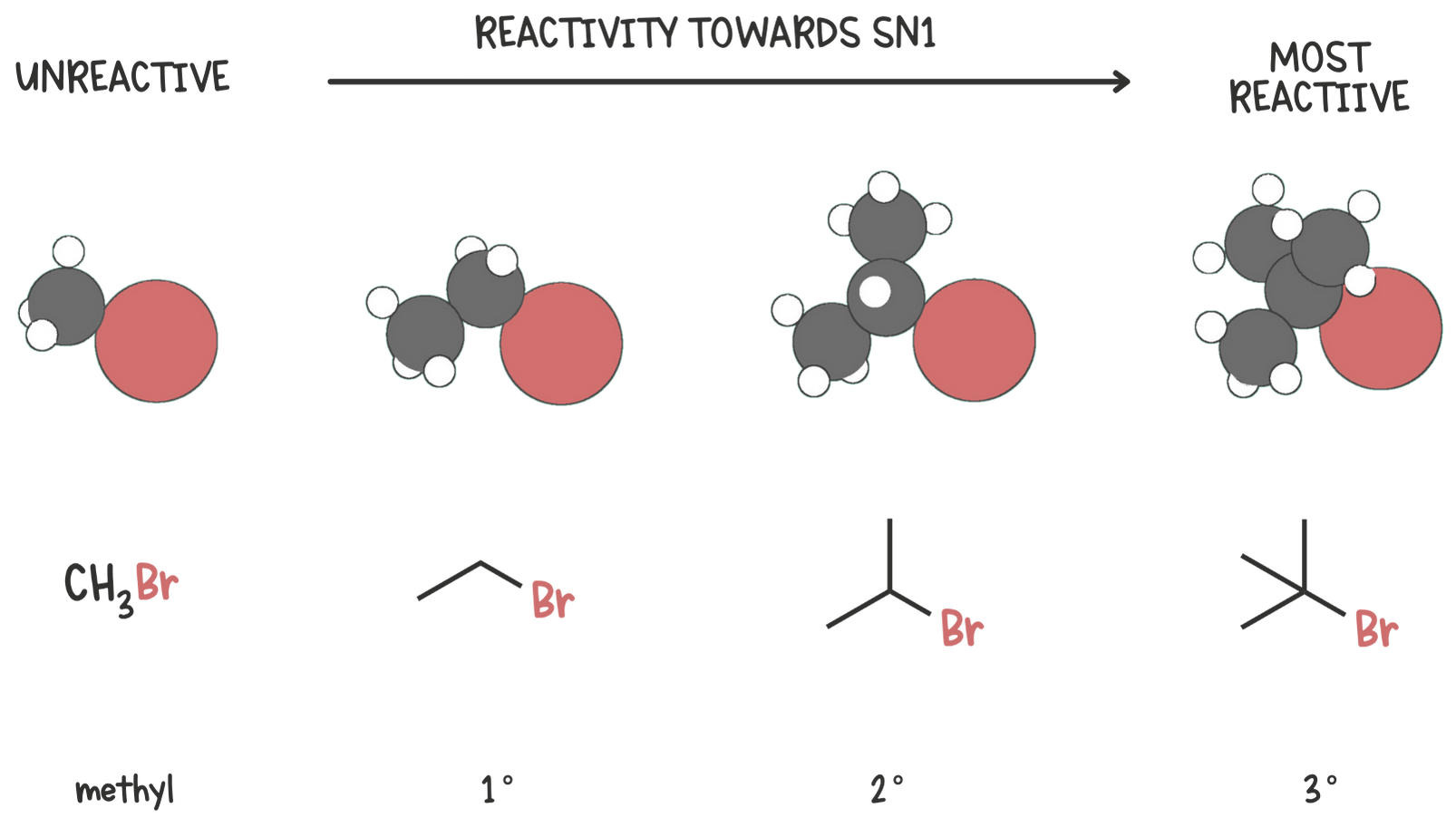
- Methyl halides are unreactive because they form highly unstable methyl carbocations.
- Tertiary halides react quickly due to the exceptional stability of tertiary carbocations.
Since we’ve already identified the type of carbon the leaving group is attached to, we can classify the carbocations accordingly. This step will help us better understand how carbocation stability influences the SN1 reaction rate.
- Molecule I forms a 1° carbocation—not very stable.
- Molecule II forms a 2° allylic carbocation—stabilized by resonance and more stable.
- Molecule III forms a 1° allylic carbocation—stabilized by resonance but less stable than 2° allylic.
- Molecule IV would form a vinylic carbocation—highly unstable and unlikely to form.
Here’s the stability order for carbocations:

Quick note on vinylic carbocations
Vinylic carbocations have the positive charge on an sp² hybridized carbon of a double bond. They’re highly unstable because the electron deficiency is on a carbon that already has a high s-character, making it less able to stabilize a positive charge.
Step 3: Assess the leaving groups
Since all molecules have bromine as the leaving group, we can focus solely on carbocation stability.
Step 4: Rank the molecules
Since the leaving group is the same across the board, we focus on carbocation stability.
- Slowest (least reactive): Molecule IV (vinylic carbocation—very unstable)
- Next: Molecule I (primary carbocation—less stable)
- Then: Molecule III (primary allylic carbocation—resonance-stabilized)
- Fastest: Molecule II (secondary allylic carbocation—more stable due to resonance and being secondary)
Final Ranking:
IV < I < III < II
Challenge 2: Ranking Molecules with Different Leaving Groups
Question:
Which alkyl halide will undergo solvolysis in aqueous ethanol most rapidly?
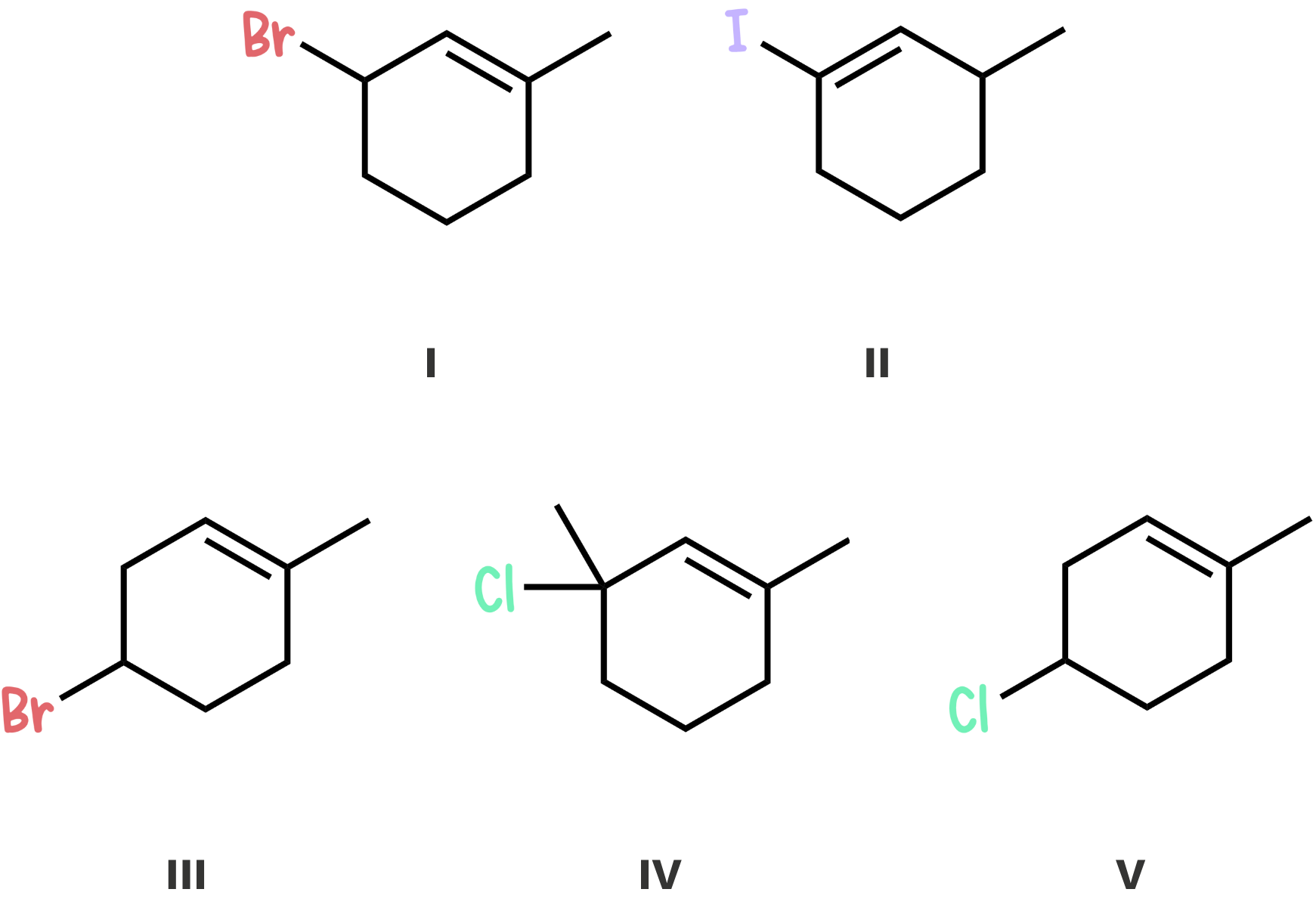
Understanding solvolysis
Solvolysis is a type of SN1 reaction where the solvent acts as the nucleophile. Here, aqueous ethanol is our solvent, which is polar protic, favoring SN1 mechanisms.
Let’s dive in!
Step 1: Identify the carbon attached to the leaving group
Remember, by figuring out the type of carbon the leaving group is attached to in each molecule. By identifying this, we can predict the type of carbocation that will form when the leaving group departs.
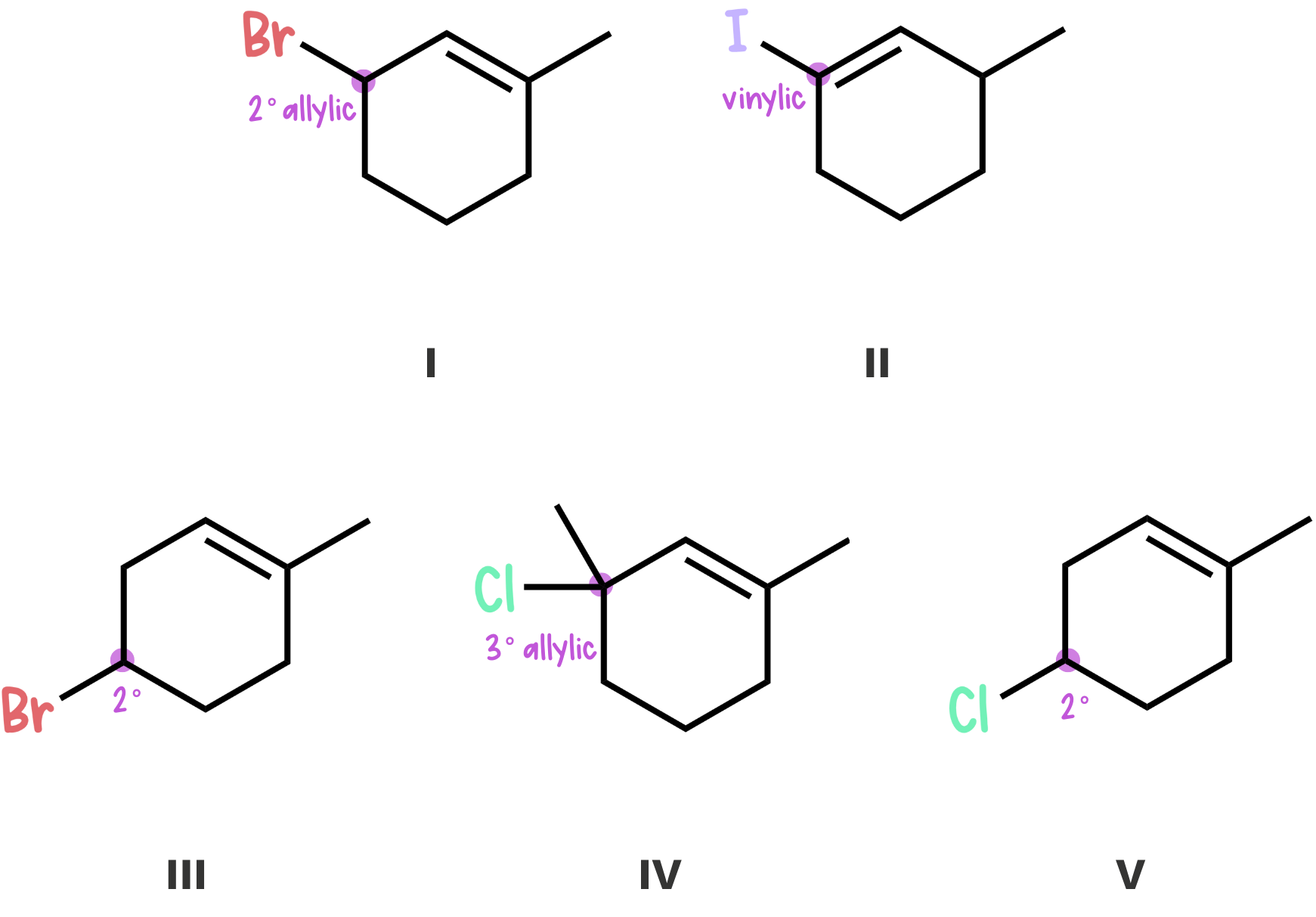
- Molecule I: Bromine is attached to a 2° allylic carbon.
- Molecule II: Iodine is attached to a vinylic carbon.
- Molecule III: Bromine is attached to a 2° carbon.
- Molecule IV: Chlorine is attached to a 3° allylic carbon.
- Molecule V: Chlorine is attached to a 2° carbon.
Step 2: Evaluate carbocation stability
Let’s remember a key point: the more stable the carbocation, the faster the SN1 reaction will go. This is our guiding principle as we look at each molecule.
- Molecule I forms a 2° allylic carbocation, stabilized by resonance and more stable than 2° carbocation.
- Molecule II would form a vinylic carbocation, which is highly unstable and unlikely to form.
- Molecule III forms a 2° carbocation.
- Molecule IV forms a 3° allylic carbocation, stabilized by resonance and more stable than a 2° allylic carbocation.
- Molecule V forms a 2° carbocation.
Here’s the stability order for carbocations:

Based on the stability of each carbocation, our ranking so far looks like this:
II < ? < ? < I < IV
Now, what about Molecules III and V?
Since they both form 2° carbocations, we’ll need another factor to decide which reacts faster. The answer lies in the leaving group! We’ll explore how leaving groups affect reactivity in the next step.
Step 3: Assess the leaving groups
Good leaving groups can better stabilize the negative charge after they leave. Here’s the general order of leaving group ability:
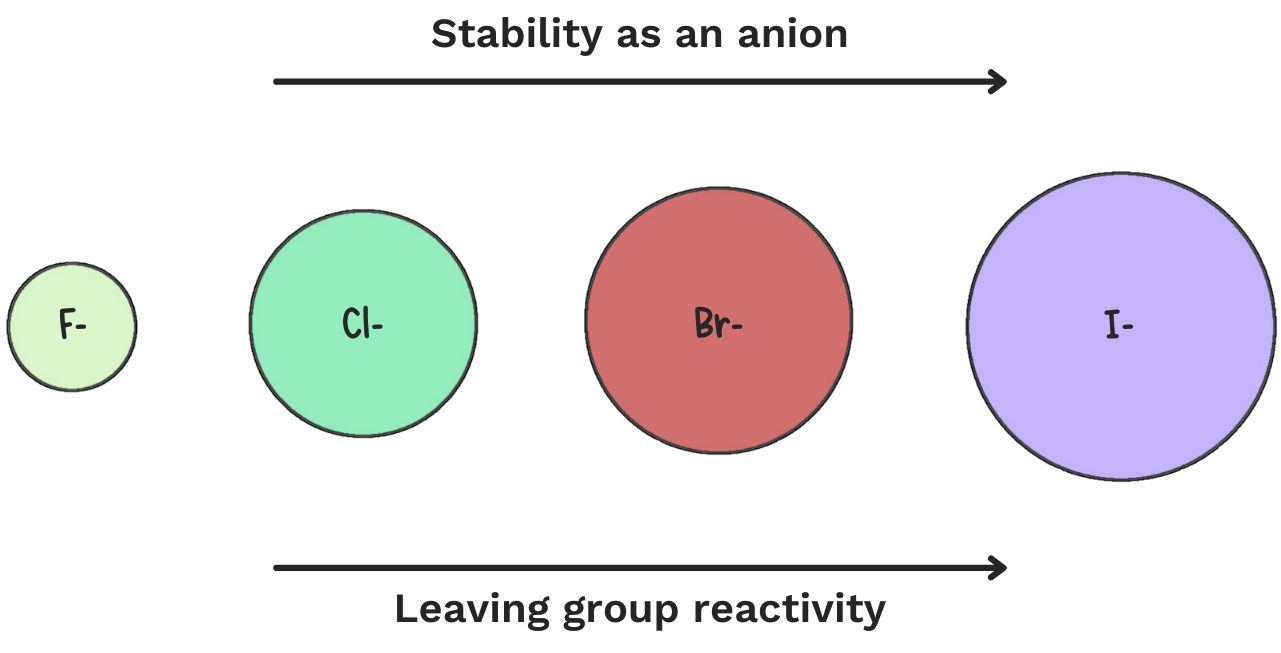
- Fluorine is the worst—it is the smallest of the halides and has a high charge density.
- Iodine is the best leaving group because it’s large and spreads out the negative charge (lower charge density).
Since bromine is larger than chlorine, it can spread out (or “diffuse”) the negative charge more easily, making it a better leaving group.
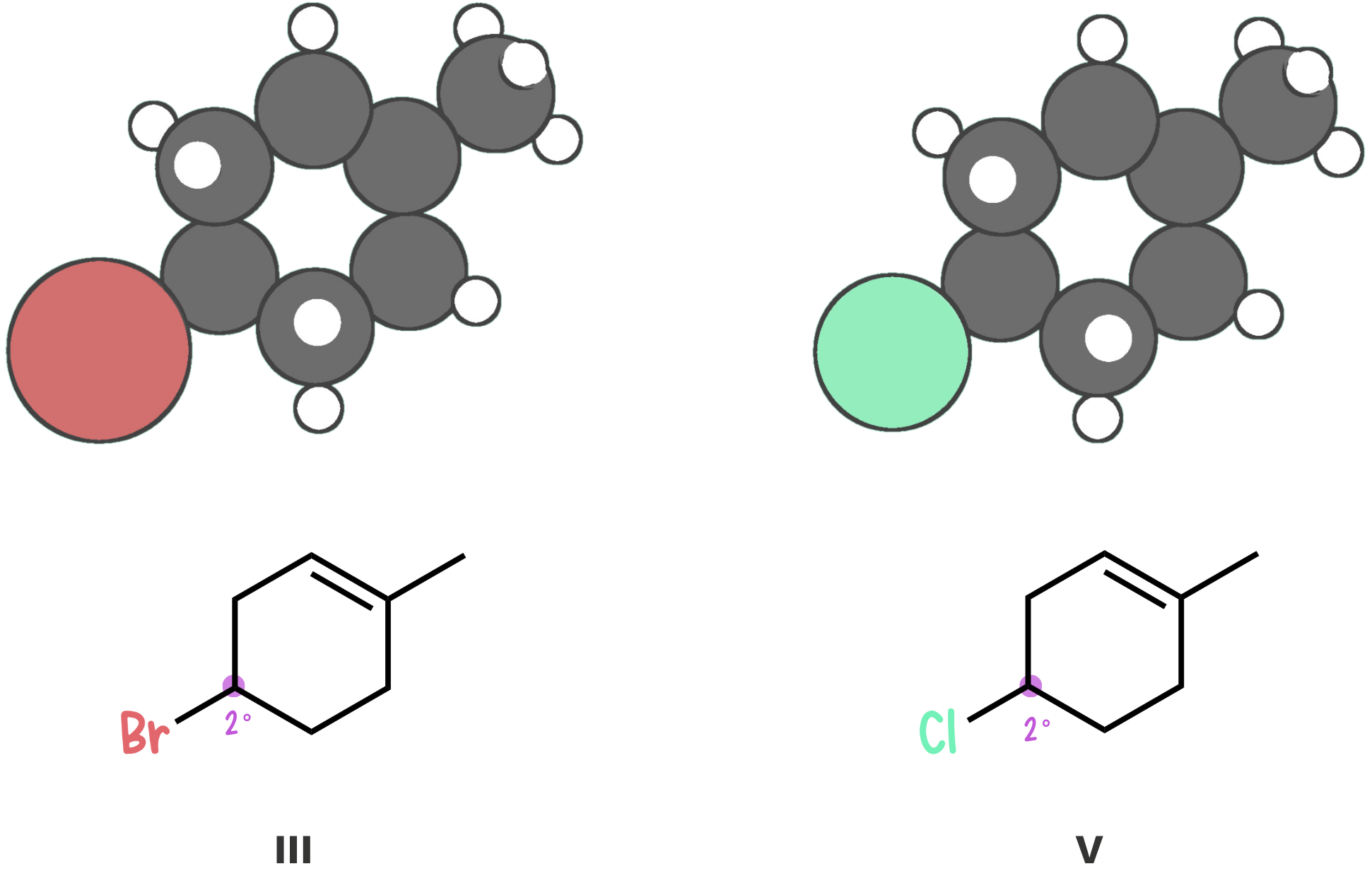
So, we’d expect Molecule III (with bromine as the leaving group) to react faster than Molecule V (with chlorine).
With this information, our ranking looks like this:
II < V < III < I < IV
Step 4: Rank the molecules
We successfully combined both carbocation stability and leaving group reactivity for our final ranking:
II < V < III < I < IV
Why?
- Molecule II forms a vinylic carbocation, which is very unstable despite having a good leaving group (I⁻).
- Molecule III and Molecule IV both form 2° carbocations, but Molecule IV reacts faster since bromine is a better leaving group than chlorine.
- Molecule I forms a 2° allylic carbocation stabilized by resonance, so it reacts faster than Molecules III and IV.
- Molecule V forms a very stable 3° allylic carbocation due to resonance and hyperconjugation, making it the fastest to react.
Challenge 3: The ultimate challenge
Question:
Rank the following molecules in order of increasing reaction rate with methanol.
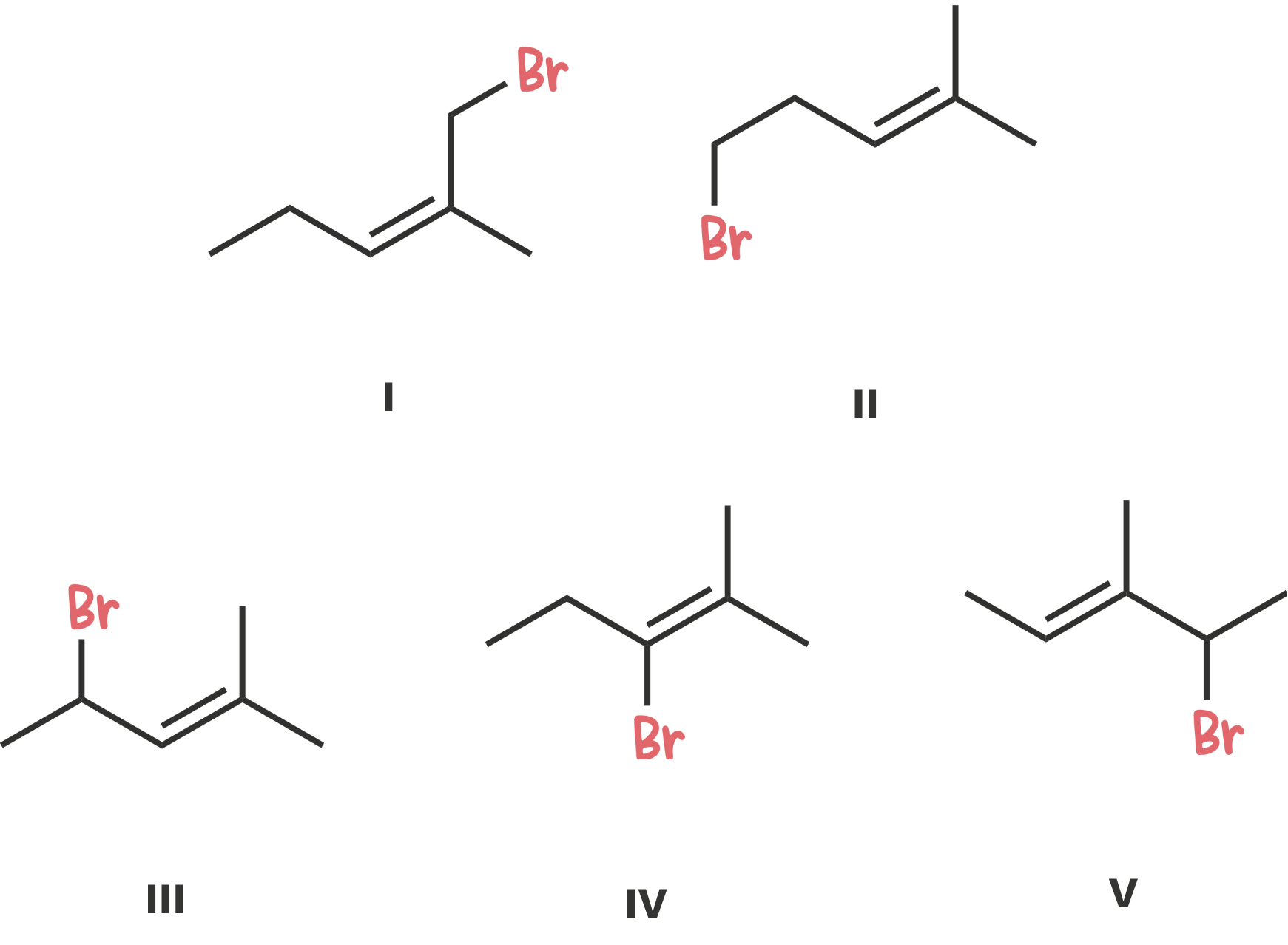
What’s happening here?
Methanol (CH₃OH) is a weak nucleophile and a polar protic solvent, which favors SN1 reactions. So, we’ll approach this as an SN1 reaction ranking.
Step 1: Identify the carbon attached to the leaving group
Let’s start by figuring out the type of carbon each leaving group (bromine) is attached to:
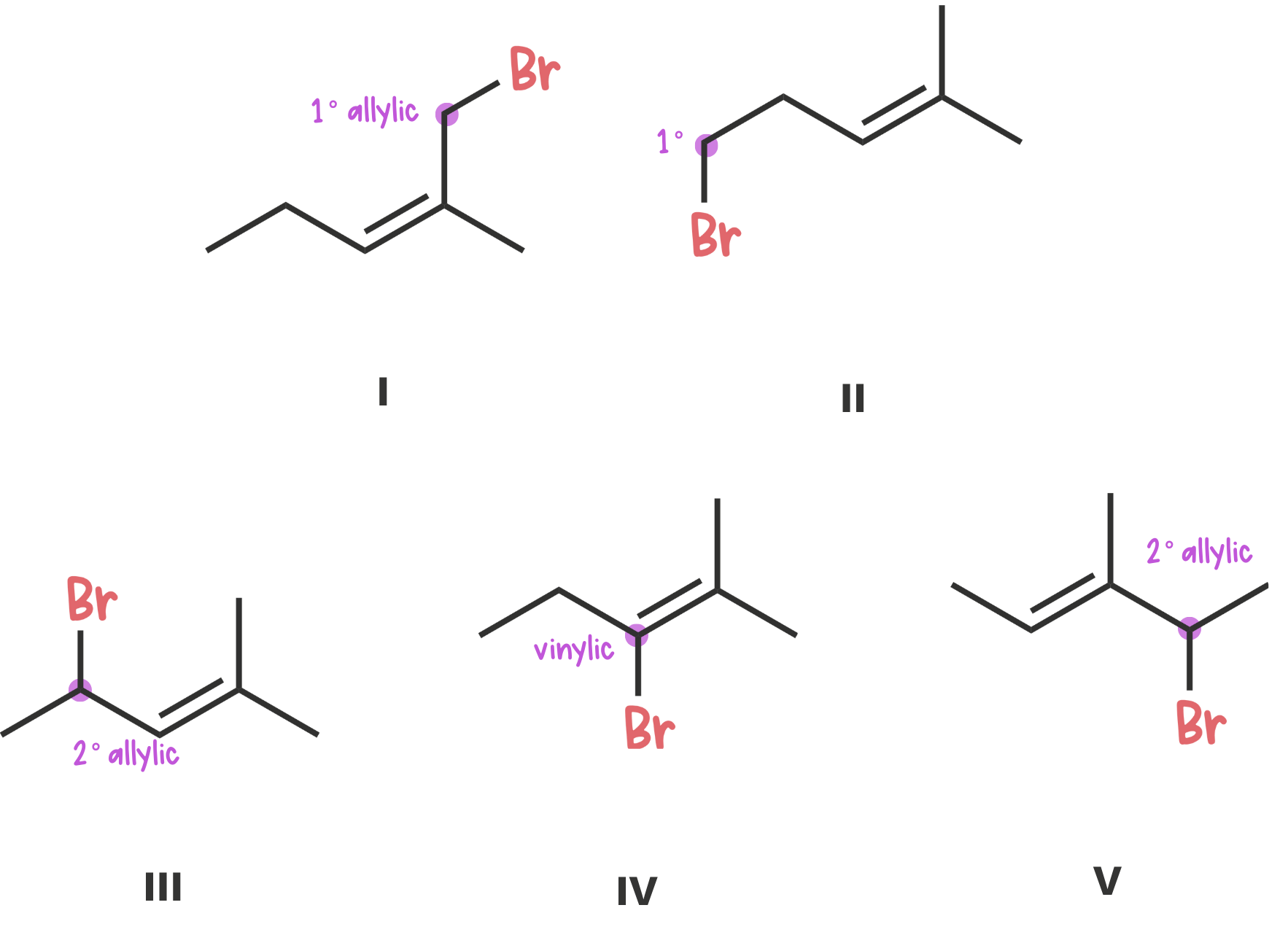
- Molecule I: Bromine is bonded to a 1° allylic carbon.
- Molecule II: Bromine is bonded to a 1° carbon.
- Molecule III: Bromine is bonded to a 2° allylic carbon.
- Molecule IV: Bromine is bonded to a vinylic carbon.
- Molecule V: Bromine is bonded to a 2° allylic carbon.
Step 2: Evaluate carbocation stability
Next, let’s look at the carbocation each molecule would form in an SN1 reaction:
- Molecule I forms a 1° allylic carbocation, stabilized by resonance and more stable than 1° carbocation.
- Molecule II forms a 1° carbocation.
- Molecule III forms a 2° allylic carbocation.
- Molecule IV would form a vinylic carbocation, which is highly unstable and unlikely to form.
- Molecule V forms a 2° allylic carbocation.
Here’s the stability order for carbocations:

Based on the stability of each carbocation, our ranking so far looks like this:
IV < II < I < ? < ?
Now, what about Molecules III and V?
Both Molecules III and IV have bromine attached to 2° allylic carbons, and since they both have the same leaving group (Br), they’re similar. But to figure out which is more reactive, let’s consider the resonance forms of the carbocations they form.
Molecule III
As mentioned earlier, Molecule III forms a 2° allylic carbocation when the leaving group departs.
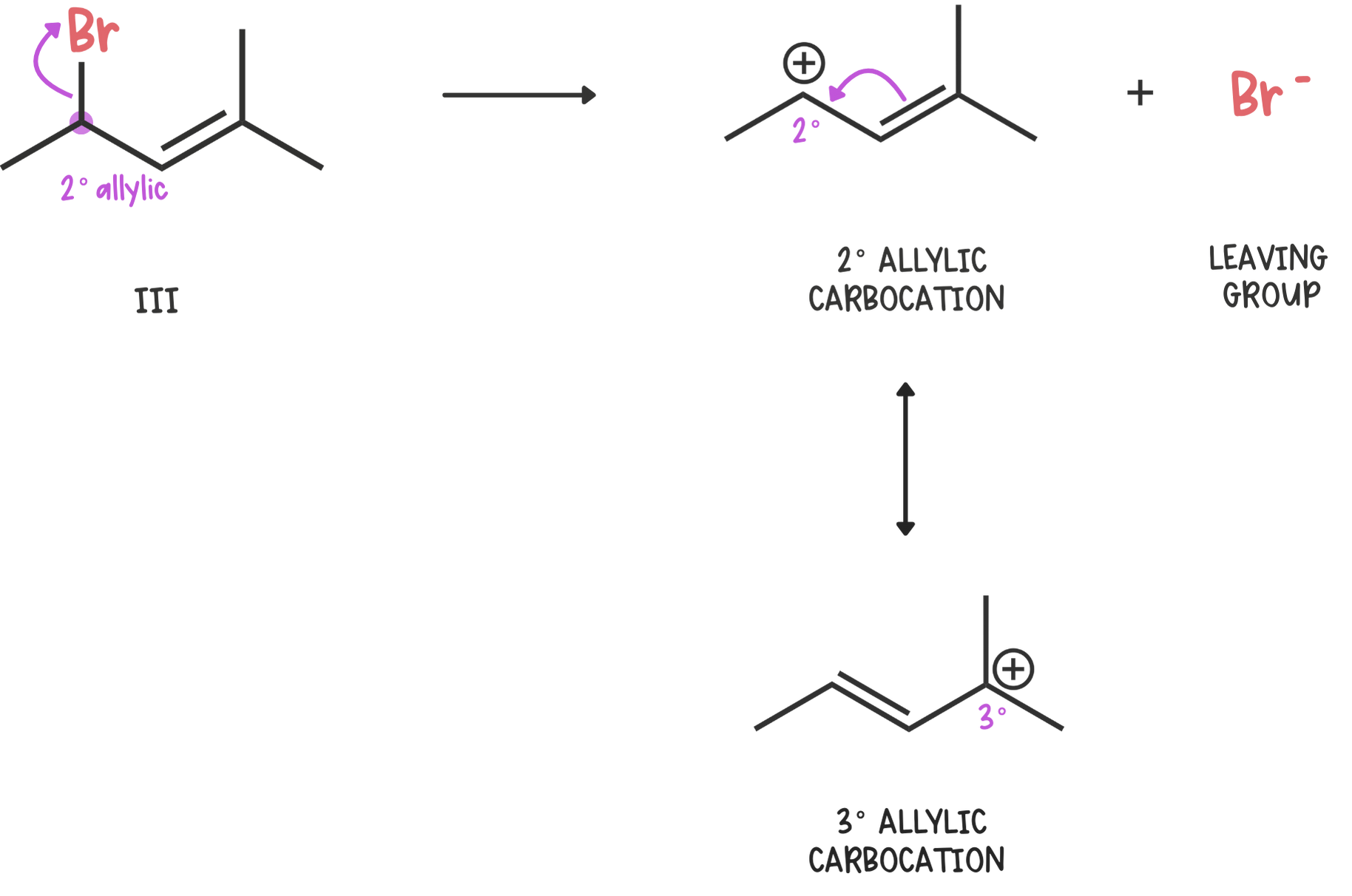
In this carbocation, the positive charge is spread out (delocalized) across both a 2° and a 3° carbon. This setup benefits from hyperconjugation provided by the tertiary (3°) carbon, which adds extra stability to the carbocation.
Molecule V
Molecule IV also forms a 2° allylic carbocation when the leaving group departs.
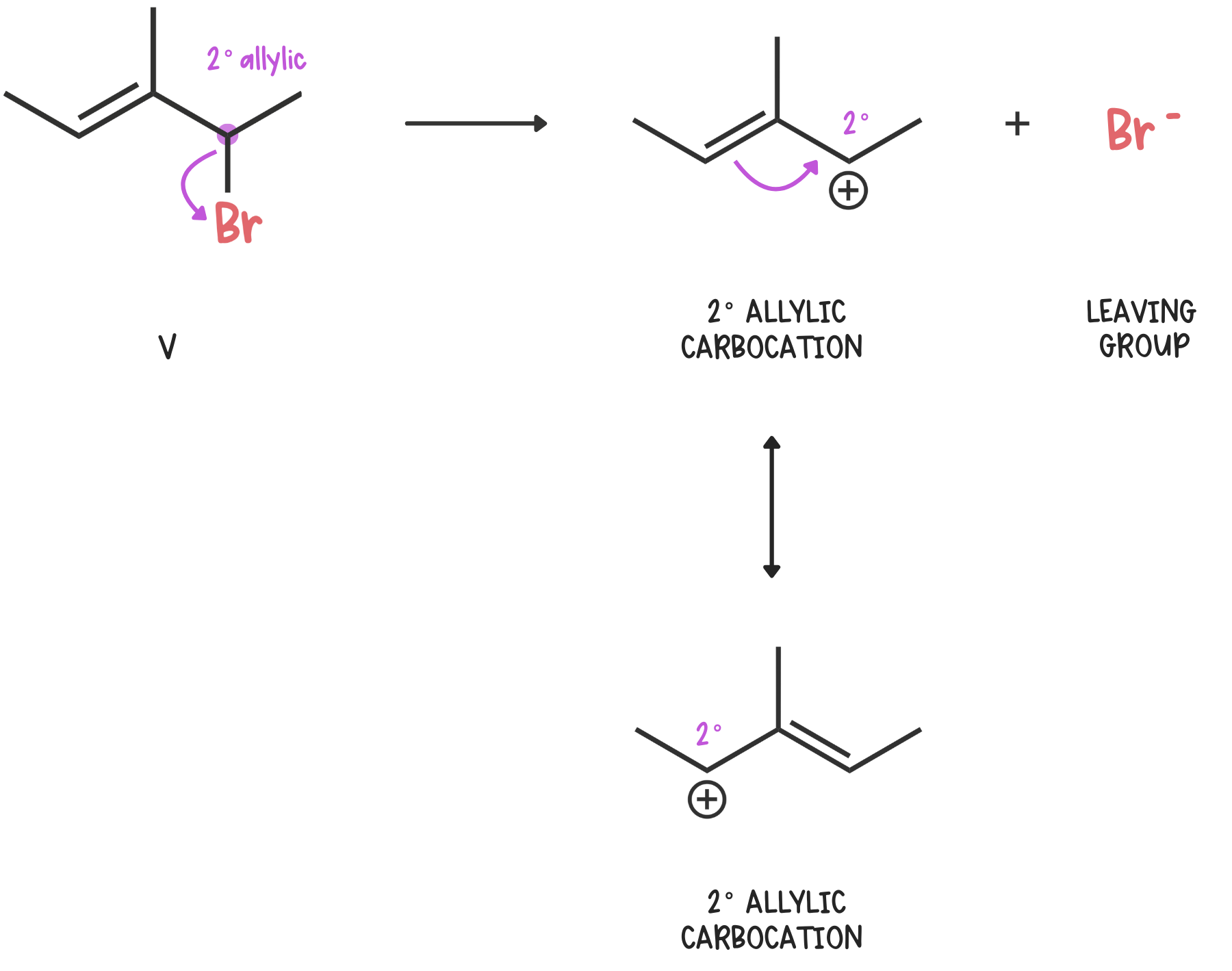
In this carbocation, the positive charge is delocalized over two 2° carbons. While still stabilized by resonance, it doesn’t benefit from the additional stability of a tertiary position.
Therefore, Molecule III will react faster than Molecule IV due to the additional stability provided by the tertiary carbon.
Our revised ranking is now:
IV < II < I < V < III
Step 3: Assess the leaving groups
All molecules have bromine as the leaving group, so we don’t need to compare them here.
Step 4: Rank the molecules
Since all the molecules share the same leaving group, we can finalize the ranking based on carbocation stability alone:
IV < II < I < V < III
You did it! 🎉
You’ve mastered the skills needed to evaluate carbocation stability, assess leaving group ability, and rank molecules based on their SN1 reactivity with confidence. Learning these concepts is a big step toward mastering organic chemistry, so give yourself a well-deserved pat on the back. Got questions or thoughts? Share them below, and I’ll be happy to help clarify anything or discuss your insights!